This document is for the HP Deskjet 3050A All-in-One printers.
Fixing Print Quality Problems for the HP Deskjet 3050A (J611) All-in-One Printer Series
The quality of a printed document or photo is not as expected. The procedures in this document should help with streaked or faded printouts, color or black ink not printing, documents with blurred or fuzzy text, ink streaks or smears, and other print quality problems.
To resolve most print quality issues, use genuine HP cartridges, and in some cases, you might need to allow the printer to rest. Check the paper and print settings to make sure that they are correct for the print job, and clean the cartridges and printhead. You might need to replace any empty or defective cartridges.
Solution one: Use genuine HP cartridges
HP recommends that you use genuine HP ink or toner supplies. HP cannot guarantee the quality or reliability of non-HP or refilled cartridges. If you do not use genuine HP cartridges, the steps in this document might not resolve the issue. To check the authenticity of your cartridges, go to the HP anti-counterfeit webpage (in English).
Purchase replacement cartridges and other supplies from the HP Store or local retailers.
Solution two: Allow the printer to rest
Sometimes, print quality issues can be resolved during a period of inactivity. Consider waiting for about 30 minutes, and then try the print job again.
Solution three: Do not leave photo paper in the input tray
If photo paper is left in the tray for too long, a reaction between the paper rollers and the photo paper might occur. This can result in lines or marks on the printed photo.
Recommendation: Do not leave photo paper in the tray for more than 30 minutes. Only leave photo paper in the tray when you want to print on photo paper. Store the photo paper in a resealable bag when not in use.
Solution four: Check the paper
Use the following guidelines to make sure that the paper you are using is appropriate for the print job. If it is not, reload the printer with an appropriate paper type.
note:To purchase paper in the United States and Canada, go to the HP Store.
-
Load the paper print side down in the input tray. Many papers have printing and nonprinting sides, such as photo paper and envelopes. Usually, the smoother side is the "print side," and sometimes the non-print side has a logo of the paper manufacturer on it.
-
Do not use wrinkled or curled paper. Use only clean, wrinkle-free paper.
-
Use the correct paper type for your project.
-
For everyday text documents, plain paper with ColorLok technology works well. Paper with ColorLok technology is industry-standard paper that works well with HP ink.
-
For documents with dense printing, such as high contrast graphics or photos, use HP Advanced Photo Paper for best results.
-
Some paper might not absorb ink as well as others. If your prints smear easily, make sure you are using a recommended paper.
-
-
Store photo paper in its original packaging inside a resealable plastic bag. Store the paper on a flat surface in a cool, dry place. Load 10-20 sheets of photo paper only when you are ready to print, and then put the unused paper back in the packaging.
-
Try using a different paper. This determines if the problem is related to the paper.
note:Inappropriate, damaged, or unsupported paper can cause vertical streaks in printouts.
|
Examples of horizontal and vertical streaks in a printout
|
|

If your printout contains horizontal lines or other print quality issues besides vertical streaks, continue to the next step.
|

Do not replace cartridges for vertical streaks in a printout. Instead, check the paper as described earlier in this document or search for a document that covers this issue. Vertical streaks in copies can often be fixed by cleaning the scanner glass.
|
After trying the preceding guidelines, try to print again.
Solution five: Check the print settings
The print settings mignt be the cause of incorrect colors or print quality issues. Follow these steps to check the print settings for your print job.
Solution six: Check the estimated ink levels, and then replace any low or empty cartridges
Follow these steps to check the ink levels, and then replace any low or empty cartridges.
Step one: Check the estimated ink levels
Follow these steps to check the estimated ink levels.
-
On the control panel, press the Setup (
 ) button.
) button.
-
Press the button (
 ) next to the Down Arrow (
) next to the Down Arrow ( ), and then press the button (
), and then press the button ( ) next to Ink Levels.
) next to Ink Levels.
-
Press the button (
 ) next to OK. The ink level graphic displays.
) next to OK. The ink level graphic displays.
Figure : Estimated ink levels
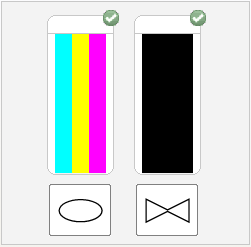
note:Ink level warnings and indicators provide estimates for planning purposes only. When an indicator shows low ink levels, consider having a replacement ink cartridge available to avoid possible printing delays. You do not need to replace ink cartridges until print quality becomes unacceptable.
-
If none of the ink cartridges are low on ink, you do not need to replace them yet. Continue to the next solution.
-
If any of the ink cartridges are low on ink, continue to the next step to replace them.
Step two: Replace any low or empty cartridges
Follow these steps to replace any low or empty cartridges.
Video of replacing the cartridges
The following video demonstrates how to replace a cartridge.
note:The video shows the HP Deskjet 3050. The outside of the product might not look the same as your product, but the steps are the same.
.
If you have trouble viewing the video or to view the video in a different size, click here to play the video on YouTube.
-
Load plain white paper in the input tray.
-
Press the Power button to turn on the printer.
-
Open the cartridge door. The carriage moves to the center of the printer. Wait until the carriage is idle and silent before you continue.Figure : Open the cartridge door
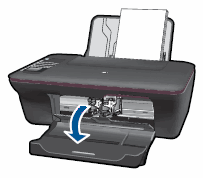
-
Lightly press down on the cartridge to release it, and then pull the cartridge out to remove it from its slot.Figure : Remove the cartridge
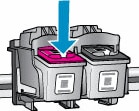
caution:
Do not touch the copper-colored contacts or the ink nozzles. Touching these parts can result in clogs, ink failure, and bad electrical connections.Figure : Do not touch the contacts or nozzles
-
Remove the new cartridge from its packaging, and then pull the pull tab to remove the plastic tape.
caution:
Do not touch the copper-colored contacts or ink nozzles. Also, donot re-tape the cartridges. Doing so can result in clogs, ink failure, and badelectrical connections.Figure : Remove the plastic tape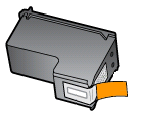
-
Hold the cartridge by its sides with the contacts toward the printer and the nozzles facing down toward the bottom of the printer, and then insert the cartridge into its slot.
-
The tri-color cartridge (
 ) goes in the slot on the left
) goes in the slot on the left
-
The black cartridge (
 ) goes in the slot on the right
) goes in the slot on the right
Figure : Insert the cartridge into its slot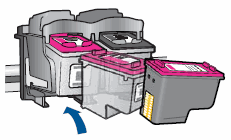
-
-
Push the cartridge forward into its slot until it snaps into place.
-
Repeat these steps to replace the other cartridge, if necessary.
-
Close the cartridge access door.Figure : Close the cartridge access door
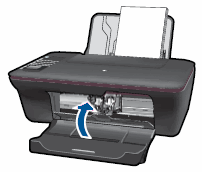
-
Press the button (
 ) next to OK.
The printer prints an alignment page.
) next to OK.
The printer prints an alignment page.
Step three: Align the cartridges
Follow these steps to align the cartridges.
-
Lift the scanner lid.
-
Place the alignment page with the printed-side down on the right-front corner of the scanner glass. See the engraved guide next to the scanner glass to help load the alignment page.Figure : Place the alignment page on the scanner glass
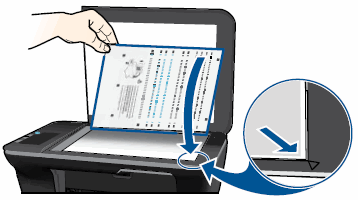
-
Close the scanner lid.
-
Press the button (
 ) next to OK.
The product scans the alignment page.
) next to OK.
The product scans the alignment page. -
When the Alignment successful message displays on the control panel screen, press the button (
 ) next to OK to complete the alignment.
) next to OK to complete the alignment.
Solution seven: Print and evaluate a Printer Status Report and troubleshoot defects
Follow these steps to print, and then evaluate the Printer Status Report.
Step one: Print a Printer Status Report
-
Load plain white paper in the input tray.
-
On the product control panel, press Setup (
 ). The Setup menu displays.
). The Setup menu displays.
-
Press the button (
 ) next to the Down Arrow (
) next to the Down Arrow ( ) to select Tools, and then press the button (
) to select Tools, and then press the button ( ) next to OK. The Tools menu displays.
) next to OK. The Tools menu displays.
-
Press the button (
 ) next to the Down Arrow (
) next to the Down Arrow ( ) to select Printer Status Report, and then press the button (
) to select Printer Status Report, and then press the button ( ) next to OK. The Printer Status Report prints.
Figure : Example of the Printer Status Report
) next to OK. The Printer Status Report prints.
Figure : Example of the Printer Status Report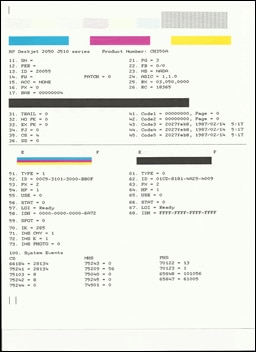
Step two: Check the Printer Status Report for defects
Different cartridges print different areas of the Printer Status Report. Follow these guidelines to determine which cartridge printed which areas.
-
Printed by the color cartridge
-
Printed by the black cartridge
Figure : Which cartridges print which areas of the Printer Status Report
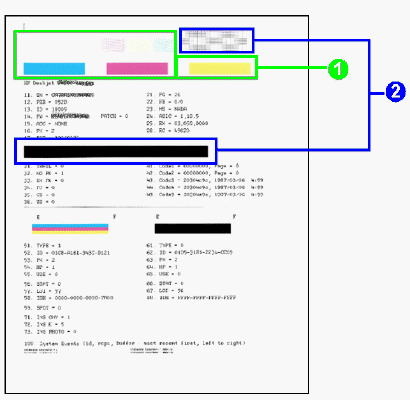
Make a note of which ink cartridges printed which areas of the Printer Status Report, and then check the report for defects.
In general, if the printer and its ink cartridges are working correctly, all the color bars should be present, unstreaked, and uniform in color. The black text on the page should not show ink streaks.
Use the following table for examples of defects that can exist on the Printer Status Report. The following examples are not inclusive, but they tend to represent the most common issues.
|
Examples of defects on the Printer Status Report
|
||
|
Defect
|
Example
|
Description or cause
|
|
Broken lines in grid patterns
|
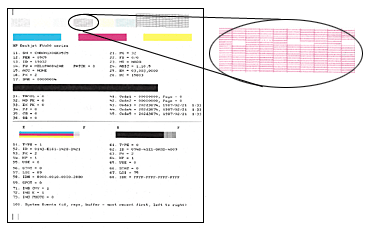
|
Problem with the ink nozzles
|
|
Faded or nonuniform colors in the color blocks
|

|
Depleted ink cartridges, or ink mixing together
|
|
Track marks or ink smears in the text
|

|
Fibers or other debris on one or both of the ink cartridges
|
|
The color blocks are streaked or lined
|
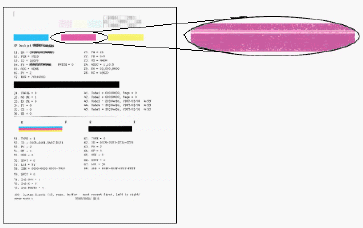
|
The cartridge might be running out of ink or the nozzles might be clogged
|
|
One or more of the colored blocks is missing entirely
|
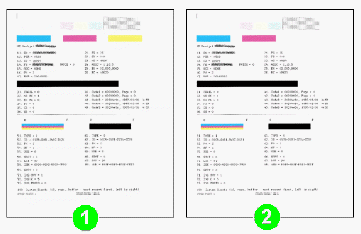
|
The cartridge is out of one color of ink or the ink nozzles might be clogged.
|
-
If you do not see defects on the test page, the print mechanism and ink cartridges work correctly. Do not continue the troubleshooting steps in this document. If printouts are still unsatisfactory, try the following general print quality guidelines.
-
Make sure that the image you are printing has sufficient resolution. Images that are enlarged too much might appear fuzzy or blurry.
-
If the issue is confined to a band near the edge of a printout, use the software you installed with the printer or another software program to rotate the image 180 degrees. The problem might not display on the other end of the printout.
 Windows only: If you are experiencing garbled, jumbled or illogical text, incomplete printouts, or missing text or graphics, go to Continuous Pages of Strange or Garbled Characters Print in Windows
Windows only: If you are experiencing garbled, jumbled or illogical text, incomplete printouts, or missing text or graphics, go to Continuous Pages of Strange or Garbled Characters Print in Windows -
-
If you see one or more of these defects on the test page, continue to the next step.
Step three: Align the cartridges
Follow these steps to align the cartridges.
-
Load plain white paper in the input tray.
-
On the product control panel, press Setup (
 ). The Setup menu displays.
). The Setup menu displays.
-
Press the button (
 ) next to the Down Arrow (
) next to the Down Arrow ( ) to select Tools, and then press the button (
) to select Tools, and then press the button ( ) next to OK. The Tools menu displays.
) next to OK. The Tools menu displays.
-
Press the button (
 ) next to the Down Arrow (
) next to the Down Arrow ( ) to select Alignment, and then press the button (
) to select Alignment, and then press the button ( ) next to OK. The alignment page prints.
) next to OK. The alignment page prints.
-
Lift the scanner lid.
-
Follow the instructions on the control panel to finish the alignment.
Step four: Use an automated tool to clean the printhead
If you found defects on the alignment page, the printhead could be clogged. Follow these steps to run an automated tool to clean the printhead.
note:To avoid issues that require cleaning, always turn the printer off with the Power button.
-
Load plain white paper in the input tray.
-
On the product control panel, press Setup (
 ). The Setup menu displays.
). The Setup menu displays.
-
Press the button (
 ) next to the Down Arrow (
) next to the Down Arrow ( ) to select Tools, and then press the button (
) to select Tools, and then press the button ( ) next to OK. The Tools menu displays.
) next to OK. The Tools menu displays.
-
Press the button (
 ) next to the Down Arrow (
) next to the Down Arrow ( ) to select Clean Printhead, and then press the button (
) to select Clean Printhead, and then press the button ( ) next to OK. The printer cleans the printhead and then prints a printhead test page.
) next to OK. The printer cleans the printhead and then prints a printhead test page.
-
Review the print quality on the printhead test page. If the print quality is still unacceptable, follow the instructions to run a Second-level clean.
-
If these steps resolved the issue, you can stop troubleshooting.
-
If the test page that you printed earlier shows track marks or smears, continue to the next step to clean the area around the ink nozzles.
Step five: Clean the area around the ink nozzles
Complete these steps only if you see track marks or smears in the text on the Printer Status Report or on your printout, skip to the next solution to replace the problem cartridge and align the cartridges.
Figure : Example of smeared text

Figure : Example of text with track marks

-
Gather the following materials:
-
Dry foam-rubber swabs, lint-free cloth, or any soft material that will not come apartor leave fibers (coffee filters work well)
-
Clean sheets of paper
-
Distilled, filtered, or bottled water (tap water might contain contaminants that candamage the print cartridges)
caution:
Do not use platen cleaners or alcohol to clean the area. These can damage the cartridge or the printer.
-
-
Press the Power button to turn on the printer, if it is not already on.
-
Open the cartridge access door. The carriage moves to the center of the printer. Wait until the carriage is idle and silent to continue.Figure : Open the cartridge access door
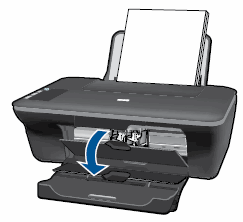
-
Lightly press down on the cartridge to release it, and then pull the cartridge out to remove it from its slot.Figure : Remove the cartridge

caution:
Do not touch the copper-colored contacts or the ink nozzles. Touching these parts can result in clogs, ink failure, and bad electrical connections.Figure : Do not touch the contacts or nozzles
-
Place the cartridge on a piece of paper with the ink nozzles up.
-
Lightly moisten a clean, foam-rubber swab with distilled water.
-
Clean the face and edges around the ink nozzle with the swab.
caution:
Do not clean the ink nozzle plate.-
Nozzle plate - DO NOT CLEAN
-
Area surrounding ink nozzle - Do clean
-
Cartridge contacts - Do not clean
Figure : Clean the area around the ink nozzle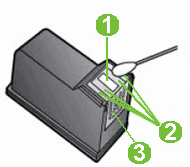
-
-
Let the cartridge sit for 10 minutes to allow the cleaned area to dry, or use a new swab to dry it.
-
Hold the cartridge by its sides with the nozzles toward the printer, and then insert the cartridge into its slot. Make sure that the icon on the cartridge matches the icon on the slot.
-
The tri-color cartridge (
 ) goes in the slot on the left
) goes in the slot on the left
-
The black cartridge (
 ) goes in the slot on the right
) goes in the slot on the right
Figure : Insert the cartridge into its slot
-
-
Push the cartridge forward into its slot until it snaps into place.Figure : Snap the cartridge into place
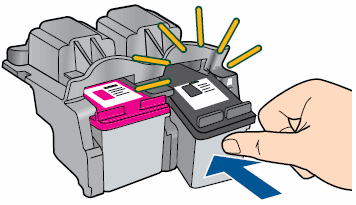
-
Repeat these steps to clean the area surrounding the ink nozzle on the other cartridge.
-
Close the cartridge access door.Figure : Close the cartridge access door
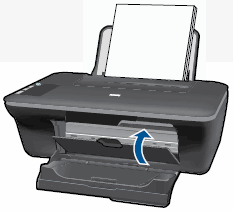
-
Try to print again.
Solution eight: Replace the problem cartridge and align the cartridges
Follow these steps to replace the problem cartridge if you saw defects on the Printer Status Report and the preceding steps did not resolve the issue, even if the cartridge is not low on ink. The problem cartridge is the one that printed the defects on the Printer Status Report as described earlier in this document.
Step one: Replace the problem cartridge
Follow these steps to replace the problem cartridge.
Video of replacing the cartridges
The following video demonstrates how to replace a cartridge.
note:The video shows the HP Deskjet 3050. The outside of the product might not look the same as your product, but the steps are the same.

If you have trouble viewing the video or to view the video in a different size, click here to play the video on YouTube.
-
Load plain white paper in the input tray.
-
Press the Power button to turn on the printer.
-
Open the cartridge door. The carriage moves to the center of the printer. Wait until the carriage is idle and silent before you continue.Figure : Open the cartridge door

-
Lightly press down on the cartridge to release it, and then pull the cartridge out to remove it from its slot.Figure : Remove the cartridge

caution:
Do not touch the copper-colored contacts or the ink nozzles. Touching these parts can result in clogs, ink failure, and bad electrical connections.Figure : Do not touch the contacts or nozzles
-
Remove the new cartridge from its packaging, and then pull the pull tab to remove the plastic tape.
caution:
Do not touch the copper-colored contacts or ink nozzles. Also, donot re-tape the cartridges. Doing so can result in clogs, ink failure, and badelectrical connections.Figure : Remove the plastic tape
-
Hold the cartridge by its sides with the contacts toward the printer and the nozzles facing down toward the bottom of the printer, and then insert the cartridge into its slot.
-
The tri-color cartridge (
 ) goes in the slot on the left
) goes in the slot on the left
-
The black cartridge (
 ) goes in the slot on the right
) goes in the slot on the right
Figure : Insert the cartridge into its slot
-
-
Push the cartridge forward into its slot until it snaps into place.
-
Repeat these steps to replace the other cartridge, if necessary.
-
Close the cartridge access door.Figure : Close the cartridge access door

-
Press the button (
 ) next to OK.
The printer prints an alignment page.
) next to OK.
The printer prints an alignment page.
Step two: Align the cartridges
Follow these steps to align the cartridges.
-
Lift the scanner lid.
-
Place the alignment page with the printed-side down on the right-front corner of the scanner glass. See the engraved guide next to the scanner glass to help load the alignment page.Figure : Place the alignment page on the scanner glass

-
Close the scanner lid.
-
Press the button (
 ) next to OK.
The product scans the alignment page.
) next to OK.
The product scans the alignment page. -
When the Alignment successful message displays on the control panel screen, press the button (
 ) next to OK to complete the alignment.
) next to OK to complete the alignment.
Solution nine: Service the printer
Service or replace your HP product if the issue persists after completing all the preceding steps.
Go to Contact HP Customer Support to schedule a product repair or replacement. If you are in Asia Pacific, you will be directed to a local service center in your area.
To confirm your warranty status, go to HP Product Warranty Check. Repair fees might apply for out-of-warranty products.
note:Keep a print sample that shows the problem. If the ink cartridges, printhead, or printer is replaced under warranty, the support agent will request the print sample. If the printer is returned to HP, the print sample must be returned with the printer. Place the sample in the output tray when you package your printer for shipping.
Enter a topic to search our knowledge library
What can we help you with?
Need Help?

